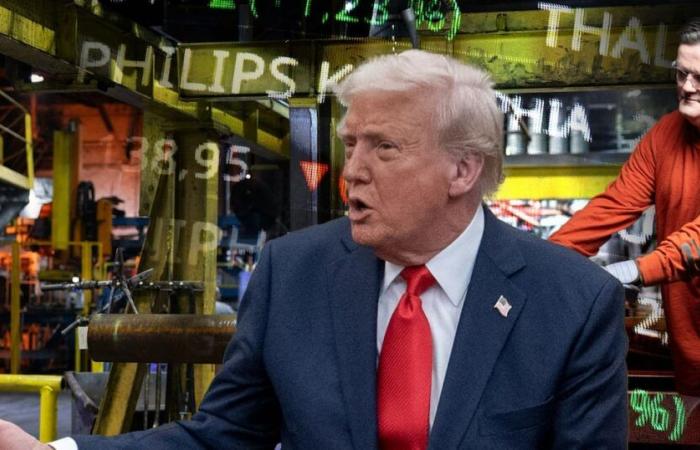Almost three months after taking office as president of the United States, Donald Trump keeps tariffs as the axis of their economic policy. While some experts consider that this measure is a ‘bullet in the foot’ for the US, the president continues with the rates and his threat of increasing them.
The question is: why? Through the tariffs, Trump has made Mexico and Canada, two of its main commercial partners, reinforce their security actions on the border and against fentanyl, there is a more important reason: revitalize the US economy.
The fact of raising prices to imports may sound contradictory and thereby helping the economy of Americans; However, Trump ‘plays it’ with tariffs for rescue some of the most hit economic sectors of the United States.
Trumpconomics 1.0: What are Trump’s objectives with tariffs?
during his confirmation hearing as secretary of the Treasury in early January, Scott Besent offered an advance of the three ways in which Trump would use tariffs.
One of the goals is increase income for the federal budgetwhich would be important to help pay Trump’s plans to extend tax cuts; and to use them as lever with foreign powers instead of sanctions, that Trump believes that they have been used in excess.
These are the three main axes in which Trump wants to strengthen the economy of the United States through tariffs:
Promote US manufacturing
Donald Trump wants to use tariffs to revitalize manufacturing and prevent the United States from ‘stapled’ by other countries due to commercial imbalances. Has raised the idea of using a combination of tariffs and incentives, such as accelerated permissions approval, to Encourage companies to build their facilities In the United States.
“We are going to recover companies”he declared during an interview with John Micklethwait, chief editor of Bloombergin the Chicago Economic Club in October. “We are going to reduce taxes for companies that manufacture their products in the United States. We will protect those companies with strong tariffs.”
Trump imposed several rounds of tariffs on Chinese products during his first mandate and said he was just beginning to use them to rebuild the US economy, when the pandemic of COVID-19 hit and disrupted his plans.
When he announced the reciprocal tariffs, Trump suggested that his purpose is to provide US business partners with the opportunity to reach agreements to avoid charges. The president wants countries to eliminate rates charged to the US.
Income increase
Income generated by tariffs could help finance the fiscal sales promised by Trump. He wants to extend the income tax reductions approved in 2017 during his first presidency, many of which expire at the end of 2025. In addition, he has submitted proposals for Expand these tax exemptionsfor example, exempting tank taxes and social security profits from workers. It also intends to cut the corporate tax rate from 21 to 15 percent.
“President Trump wants to move from the world of income taxes and innumerable IRS agents (internal tax service) to the world where tariffs, as in the era of (President William) McKinley, will finance a large amount of government that We must pay and reduce our taxes”Said Peter Navarro, Trump’s commercial advisor, to CNBC In January.
Tariffs as ‘diplomatic tool’
Howard Lutnick framed the tariff plan as a means to recover the respect of the world during his confirmation hearing as secretary of Commerce, telling the senators that both allies and the United States adversaries “are taking advantage of us, are taking advantage of us, They are missing respect And I would like to see that end. ”
-According to Besent, Trump has become skeptical about sanctions because they move away other dollar countries and see tariffs like A way to gain influence on negotiations.
Trump’s tariff orders on imports from Mexico, Canada and China – the three world commercial partners, who together represented about 40 percent of all merchandise trade last year – aim to address what he calls A “threat to the security of Americansincluding the public health crisis caused by deaths due to fentanyl consumption. ”
The decision to delay tariffs on the imports of Mexico and Canada twice occurred after their governments agreed to intensify efforts to address illegal migration and drug trafficking at the border with the United States, and Trump said At that moment I was satisfied with progress.

The current situation of Donald Trump’s tariffs: Which ones are in force?
After reciprocal tariff rates that remain in force:
How do Trump’s tariffs work and how radical are they?
A tariff, also known as law or tax, is usually calculated as a percentage of the value of a merchandise (declared during customs office) and is assigned according to your country of origin. This is complicated when a product is assembled with pieces that cross several borders, such as a car with components made in the United States that is assembled in Mexico and reimits to the United States. A tariff can also be applied as A fixed amount to each article.
The goods that cross borders receive numerical codes according to a standardized nomenclature called the international harmonized system. Tariffs can be assigned to specific product codes, for example, with the chassis of a truck, or broader categories, such as electric vehicles. Customs agencies Tariffs collect in the name of governments.
Bloomberg Economics He estimated on April 10 that, even considering Trump’s suspension of most reciprocal tariffs, the average tariff on imports in the United States had increased just over 26 percent, The highest level since the early twentieth century. The tariff stood at 2.3 percent last year.

Who pays Trump’s tariffs and how do they affect the EU economy?
The tariffs are paid by the importer or an intermediary that acts in his name, although the costs are usually impact. Trump argues that, ultimately, it is the exporter who ends up assuming the cost of a tariff. Various studies have shown that The load is more diffuse.
The foreign company that manufactures the product could decide to lower its prices as a concession to the importer, or invest in the construction of a factory elsewhere to avoid the tariff. As an alternative, the importer – as Walmart Inc. and Target Corp., two of the largest importers in the United States – could upload the price of the product to protect their profit margin, which means that The consumer indirectly assumes the cost of the tariff.
It may be difficult to analyze the economic effects of tariffs. These can stimulate employment attracting investmentsince companies try to evade tariffs moving factories to the country that gravels them.

At the same time, jobs can be lost in other sectors of the economy when tariffs cause reprisals by affected countriesas has happened with Trump’s most recent tariffs.
When a country imposes tariffs on imports, national manufacturers do not necessarily rush to make affected products. And if the country does not have an alternative internal supply of the goods in question, The prices of these goods can rise.
A 2018 Federal Reserve model suggests that each increase in 1 percentage point in the tariff rate reduces the gross domestic product by 0.14 percent and Increase prices by 0.09 percent. Based on that model, Bloomberg Economics He estimates that tariffs imposed by the Trump administration could reduce GDP by 3.4 percent and add 2 percent to inflation.






